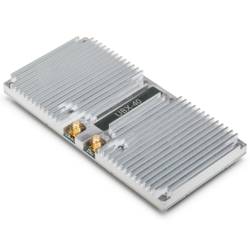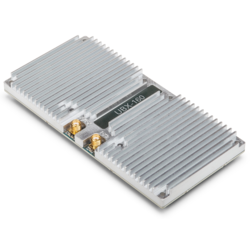UBX
Contents
- 1 Device Overview
- 2 Key Features
- 3 Daughterboard Specifications
- 4 RF Specifications
- 5 Hardware Specifications
- 6 Environmental Specifications
- 7 USRP Compatibility
- 8 Phase Synchronization
- 9 Schematics
- 10 Key Component Datasheets
- 11 Mechanical Information
- 12 RF Connectors
- 13 Certifications
- 14 Certificate of Volatility
- 15 Important Notes
- 16 RF Performance Data
- 17 Downloads
Device Overview
The UBX daughterboard is a full-duplex wideband transceiver that covers frequencies from 10 MHz to 6 GHz. Coherent and phase-aligned operation across multiple UBX daughterboards on USRP X Series motherboards enables users to explore MIMO and direction finding applications. The UBX daughterboard works interchangeably with other USRP daughterboards and is supported by the USRP Hardware Driver™ (UHD) software API for seamless integration into existing applications.
The UBX is capable of phase coherent operation, and therefore is suitable for MIMO and Phased Array applications, on the X Series. Additionally this capability is only available on the X Series devices.
Key Features
|
Daughterboard Specifications
Features
- 2 quadrature frontends (1 transmit, 1 receive)
- Defaults to direct conversion
- Can be used in low IF mode through lo_offset with uhd::tune_request_t
- Independent receive and transmit LO's and synthesizers
- Allows for full-duplex operation on different transmit and receive frequencies
- Can be set to use Integer-N tuning for better spur performance with uhd::tune_request_t
Antennas
Transmit: TX/RX
Receive: TX/RX or RX2
- Frontend 0: Complex baseband signal for selected antenna
- Note: The user may set the receive antenna to be TX/RX or RX2. However, when using a UBX board in full-duplex mode, the receive antenna will always be set to RX2, regardless of the settings.
Gains
- Transmit Gains: PGA0, Range: 0-31.5dB
- Receive Gains: PGA0, Range: 0-31.5dB
Bandwidths
- UBX: 40 MHz, RX & TX
- UBX-160: 160 MHz, RX & TX
Sensors
- lo_locked: boolean for LO lock state
LEDs
- LOCK: Synthesizer Lock Detect
- TX/RX TXD: Transmitting on TX/RX antenna port
- TX/RX RXD: Receiving on TX/RX antenna port
- RX2 RXD: Receiving on RX2 antenna port
RF Specifications
Freq Range
- 10MHz - 6GHz
Noise Figure
- 10 MHz - 500 MHz: 3 - 4 dB
- 500 MHz - 1.5 GHz: 2 - 3 dB
- 1.5GHz - 6GHz: 4 - 10 dB
RX IIP3 (Max)
- 10 MHz - 6 GHz: 8 - 9 dBm
RX IQ Imbalance
- 10 MHz - 6 GHz: < -30dBc
TX Power (Max)
- 10 MHz - 3 GHz: 20 dBm
- 3 - 6 GHz: 8 - 20 dBm
TX OIP3
- 10 - 500 MHz: 41 dBm
- 0.5 - 3 GHz: 36 dBm
- 3 - 6 GHz: 26 dBm - 36 dBm
TX IQ Imbalance
- 10 MHz - 6 GHz: < -30 dBc
Note: The UBX 160 transmitter path has 160 MHz of bandwidth throughout the full frequency range of the device; the receiver path has 84 MHz of bandwidth for center frequencies from 10 MHz to 500 MHz.
Input/Output Impedance
- All RF Ports are matched to 50 Ohm with -10dB or better return loss generally. Detailed test is pending.
Hardware Specifications
- Ettus Research recommends to always use the latest stable version of UHD
UBX-40
- Current Hardware Revision: 1
- Minimum version of UHD required: 3.8.2
UBX-160
- Current Hardware Revision: 1
- Minimum version of UHD required: 3.8.2
Environmental Specifications
Operating Temperature Range
- 0-40 °C
Operating Humidity Range
- 10% to 90% non-condensing
USRP Compatibility
UBX-40
- N or X Series
UBX-160
- X Series only
Phase Synchronization
The UBX daughterboard is capable of phase-synchronous operation, and is recommended for phase-coherent applications. The SBX and TwinRX daughterboards are also recommended for phase-coherent applications.
If you are operating the UBX at frequencies below 1 GHz and need phase synchronization, then it is necessary to select a 20 MHz daughterboard clock rate, instead of using the default 50 MHz rate. Note that this is only required for phase synchronization below 1 GHz. The UBX can still operate below 1 GHz without setting this lower daughterboard clock rate, but it will operate without any phase synchronization capability.
If you're using a UHD program, then you can specify the lower daughterboard clock rate by including dboard_clock_rate=20e6 in the device arguments when multi_usrp::make() is first invoked.
If you're using the UHD API from a C++ program, then you can include dboard_clock_rate=20e6 in the device arguments.
If you're using GNU Radio, then you can add dboard_clock_rate=20e6 to the Device Arguments field of the properties for the UHD Sink and Source blocks.
Schematics
UBX
Key Component Datasheets
| Part Number | Description | Schematic ID (Page) |
|---|---|---|
| MAX2871 | Fractional/Integer-N Synthesizer/VCO | U3 (3); U9 (5); U19 (7); U23 (9) |
| ADL5375-05 | Quadrature Modulator | U22 (8) |
| LFCN-2250+ | Low Pass Filter | F1 (3); F24 (7); F34, F35 (10) |
| LTC5510 | Active Mixer | U15 (6) |
| LFCN-490+ | Low Pass Filter | F12 (5); F15 (6); F26 (7); F31 (9); F33, F36 (10) |
| HMC624LP4E | ATTENUATOR | U16 (6) |
| NBB-400 | Amplifier | U13 (6); U30 (11) |
| PHA-1+ | Amplifier | U31 (11) |
| ADA4927-2 | Differential ADC Driver | U6 (4) |
| ADL5380 | Quadrature Demodulator | U8 (4) |
| MGA-62563 | Low Noise Amplifier | U36 (11) |
| LFCN-1700+ | Low Pass Filter | F41 (11) |
| VMMK-3603 | Low Noise Amplifier | U34 (11) |
| LFCN-2600+ | Low Pass Filter | F14, F17 (6) |
| 855916 | SAW Filter | F16 (6) |
| LTC5510 | Active Mixer | U15 (6); U28 (10) |
| LFCN-2600+ | Low Pass Filter | F14, F17 (10) |
| TCM1-63AX+ | RF Transformer | T1 (3); T2, T3 (4); T7 (8) |
| ADA4927-2 | Differential ADC Driver | U6 (4) |
| AD8591 | Operational Amplifiers | U7 (4) |
| ADL5380 | Quadrature Demodulator | U8 (4) |
| ZXTC2062E6 | TRANSISTORS | Q1 (6) |
| HMC624ALP4E | ATTENUATOR | U16 (6); U29 (10) |
| LFCN-800+ | Low Pass Filter | F2 (3); F25 (7) |
| ADP7104-3.3 | CMOS LDO | U4, U5 (3); U10, U11 (5); U20, U21 (7); U24, U25 (9); U48 (13) |
| ADL5375-05 | Quadrature Modulator | U22 (8) |
| LTC5510 | Active Mixer | U28 (10) |
| 24LC024 | EEPROM | U38, U39 (12) |
| ADP7104-5.0 | CMOS LDO | U41, U42, U43, U44, U45, U46, U47 (13) |
| ZXTC2062E6 | TRANSISTORS | Q2, Q3, Q4, Q5 (13) |
Mechanical Information
Drawings
RF Connectors
- The UBX daughterboard features female SMA connectors for both the TX/RX and RX2 connectors.
Certifications
RoHS
As of December 1st, 2010 all Ettus Research products are RoHS compliant unless otherwise noted. More information can be found at http://ettus.com/legal/rohs-information
China RoHS
Management Methods for Controlling Pollution Caused by Electronic Information Products Regulation
Chinese Customers
National Instruments is in compliance with the Chinese policy on the Restriction of Hazardous Substances (RoHS) used in Electronic Information Products. For more information about the National Instruments China RoHS compliance, visit ni.com/environment/rohs_china.
Certificate of Volatility
UBX-40/UBX-160
Important Notes
- A larger 24W (6V, 4A) power supply is required when using a UBX-40 daughterboard and integrated GPS Disciplined Oscillator accessory together in a USRP2, USRP N200, or USRP N210 device.
- The UBX-160 transmitter path has 160 MHz of bandwidth throughout the full frequency range of the device; the receiver path has 84 MHz of bandwidth for center frequencies from 10 MHz to 500 MHz.


